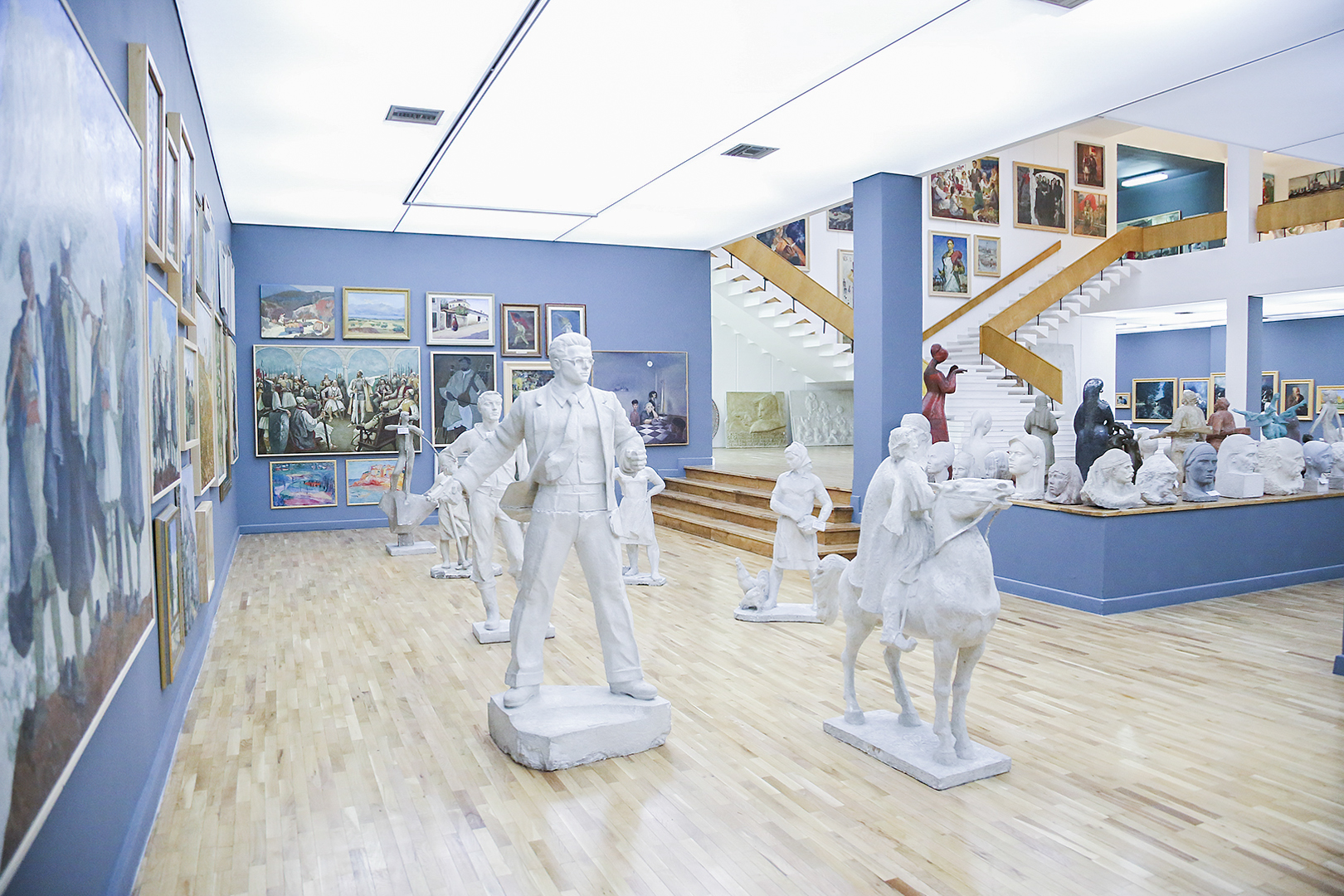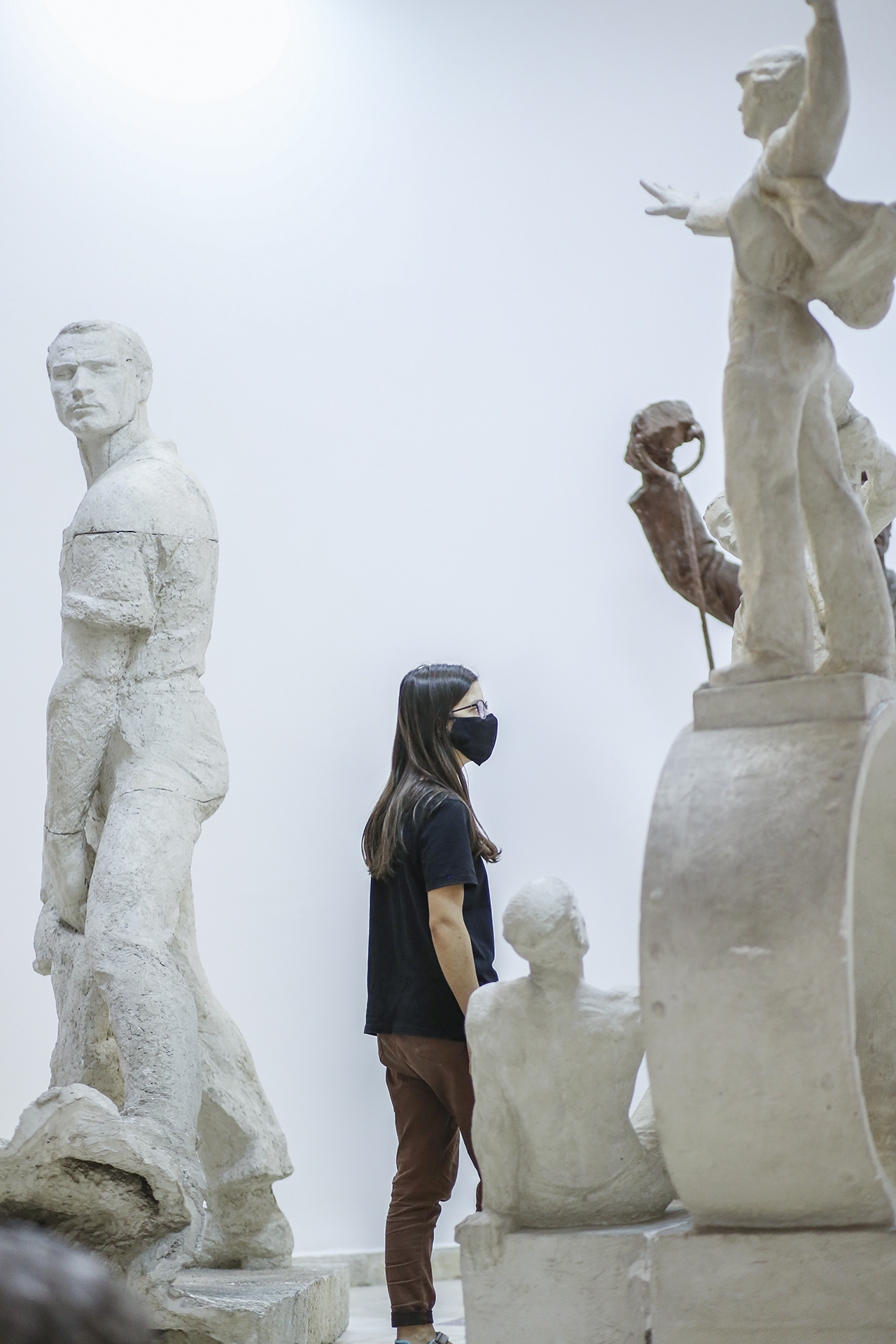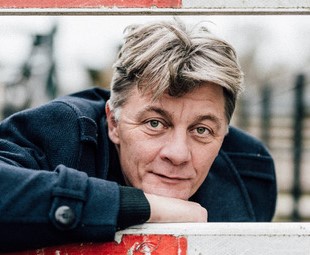“What is this miracle? How did you do this? Where did these things come from?”
Rudina Xhunga is ecstatic.
Over the years, the popular Albanian television host has frequently visited the National Gallery of Arts, an elegant white building on Tirana’s central avenue, but she’s never seen it like this. She is here to interview Erzen Shkololli, the gallery’s director. After hanging her facemask on a statue, he guides her past rows of sculptures, paintings, drawings, and ceramics. She cannot contain her excitement. “Those colors! Those faces! How can one not feel the smile of this portrait!”
Those faces, colors and the occasional smile belonged to the New Man (and Woman and Child) of communist Albania. Nine hundred of them are on show here — still just one-fifth of the National Gallery’s immense collection of socialist realism.
A boy winning a bicycle race, both arms in the air, red star pinned to his white shirt. A peasant with his white cap and white mustache, walking behind his son who carries the family’s first transistor radio. A female factory worker, surrounded by rolls of textile. Bearded warriors. Armed women. Modest nudes. Wrinkled ladies. Broad-shouldered farmers staring confidently into the distance.
The gallery sparkles. The floortiles gleam. Each space opens up to the next with an almost audible woosh. At the foot of the wide staircase to the first floor smaller and larger statues stand assembled in a half circle, welcoming the visitor, guarding the treasures. Upstairs, one painting after the other is lined up in a never-ending panorama of proletarian optimism.

One painting after the other is lined up in a never-ending panorama of proletarian optimism. Photo: Ylli Bala / Courtesy of the National Gallery of Arts, Tirana.
The last time I was here, in 2005, I had to twice ask a cranky lady in the janitor’s booth if she would be willing to turn the lights on. I was the only visitor. The building resembled the other deteriorating state galleries across this part of Europe, unequipped to, or perhaps uninterested in, preserving their legacy and connecting it to the present.
Today, I am locked down in Amsterdam. But Rudina Xhunga’s cameraman glides through the bright spaces, allowing me to zoom in on many of the individual works.
Over all these farms and factories the sky is blue. It never rained in communist Albania. But even in the abundant sunshine, the supreme leader Comrade Enver never casts a shadow. Of course he didn’t. He wasn’t like everybody else.
Enver Hoxha was creating the New Man, and art was one of his tools. The late Gëzim Qëndro, art historian and former director of the National Gallery, used to point out that this New Man was an important factor in the creation of a collective, ideologically-unified community of the Albanian people.
Hoxha had work to do when he came to power in 1944. World War II had ruined the country. Almost 80% of the population, slightly more than 1 million at the time, lived in rural areas and depended on agriculture. There was mass illiteracy. Through education, the New Man would be taught the norms and values of socialism and a new society would be built.
But until the mid-50s, Albania had no universities and because, as the anthropologist Olsi Lelaj put it, Albania was “the latecomer of the latecomers to industrialization in the Balkans,” there was no working class. In Albania, Lelaj said, the proletarian had to be carved out of the peasant.
Today, these sculpted proletarians have taken over the gallery. The farmers, proudly holding their pitchforks among the golden sheaves of wheat; the welder with his protective helmet and red-hot machine; the countless faces, young and old, humble and defiant, lined up in gray shelves across the ground floor — these were role models. This was not what Albanians actually looked like, but what they were supposed to become.
Renewing the National Gallery
Erzen Shkololli, who became the director of the National Gallery in 2018, was born in Peja, Kosovo in 1976. He survived the war, made a name for himself as an artist, ran his own art space, went on to lead the National Gallery of Kosovo and was a curatorial advisor to the prestigious contemporary art exhibition documenta 14.
Always immaculately dressed, his dark-rimmed glasses and infectious grin conceal a steely sense of mission — to elevate the artistic practice in this region to the global standards he has come to appreciate over the years.
“I approach this work from the perspective of contemporary art,” Shkololli said. Rejecting a common inferiority complex about communist-era art that would have it all hidden away, Shkololli said, “we want to make it all visible.”
“We took the work from the dusty depots, we cleaned it up and brought it into the public view,” he said. “And now, we’ll organize an oral history around it, with lectures and interviews. We’ll invite the original artists and also writers and artists from the West. This will lead to a lot of different interpretations. Back then, there was just one channel — now, there will be many.”
Over the phone, I asked him why Rudina Xhunga, the television host, exclaimed that the gallery seemed bigger than she remembered it. “Because it is,” he laughed.

The gallery sparkles, each space opens up to the next with an almost audible woosh. Photo: Ylli Bala / Courtesy of the National Gallery of Arts, Tirana.
The building was designed as an exhibition space in the ’70s by architect Enver Faja, but was then partly used as an art storage depot. Since Shkololli’s arrival they have been opening the spaces up again and restoring the original materials and building designs.
“To repair is cheaper than to build,” said Shkololli, “and this building deserves to be restored by respecting the forms used by the architect. One year from now, every space will be accessible. The building will be packed from top to bottom. The whole collection will be on view.”
Open Archive
The current exhibitions, “Tirana Patience” and “Open Archive,” were hit by calamities. Shkololli turned those into an advantage. On the day before the official opening date of both exhibits, November 27, 2019, Albania was struck by an earthquake, the country’s deadliest in a century. It killed 51 people. It also created long cracks in the gallery walls. Shkololli left them visible, as a reminder of the constant, rapid transition this region is going through, both in nature and in politics.
Then came the pandemic. Which happened to give the lay-out of the exhibitions an extra meaning. To symbolize its former closed-up nature, Shkololli had commissioned Ghanaian artist Ibrahim Mahama to cover the National Gallery with a huge patchwork of his trademark rough cloth. But now, this plan looked more like a gesture of protection, shielding the gallery from the invisible threat.
Inside, the curators Adam Szymczyk and Nataša Ilić had planned to present some statues inside colored plexiglass cubes and leave a number of paintings in the exhibit covered in white cloth, to be revealed later on. Again, inadvertently but with striking effect, under the current circumstances these interventions look protective.
Even under these circumstances, Shkololli feels the exhibit has had success. People, he said, have used it as “an escape from daily life.”
“It takes them away from their daily routines and fears,” he said. Noting the generally positive response, he said viewers “keep coming back to see paintings that they loved back then, that they recognize from children’s books, picturing places that no longer exist.”
What does it mean to escape from a daily life clouded by the pandemic and the violence of capitalism into a daily life lit up by the oppressive eternal sunshine of Albanian communism? How can scenes from the paranoid proletarianism of the past, one that hounded people in every aspect of their existence, feel like an oasis today?
This is the paradox of these exhibitions: the same socialist realism that for decades gave a brave, smiling face to a brutal dictatorship, feels like a breath of fresh air in these times. This work, created under harsh strictures, forbidden by censors from ever straying from Comrade Enver’s templates, now seems to express a glorious sense of liberty.

Viewing the work with some of the veil of ideology removed, it is clear that many of these artists were masters. Photo: Ylli Bala / Courtesy of the National Gallery of Arts, Tirana.
Part of this may be an effect of distance, the pain and paranoia subsiding after thirty years. But part of it has to do with the sheer quality of the work. By offering no political or historical context, by presenting the 900 works in simple chronological order, Shkololli and the curators highlight the art, not the ideology.
Viewing the work with some of the veil of ideology removed, it is clear that many of these artists were masters. In a country where art academies, like most educational institutions, came into being only during the ’50s, the command of craft and technique is striking. From the statuette of an introverted peasant girl’s face to the grand landscapes of rolling hills marked by the chimney pipes of brand new factories, I can only marvel at what these artists achieved within their strict limitations, and what they might have been capable of outside those restrictions.
Finding freedom in color
There was no underground scene in Albania. Any sign of dissidence led straight to the labor camps. Abstract or experimental was a no-go: western, bourgeois, decadent. The only way to stray from the standard iconography of socialist realism was through color and brushstroke.
“Some of these artists found their only moment of freedom in color,” said Shkololli. Others offered glimpses of non-functionality in their depictions of nature, towns and villages, at a time when art was expected to be nothing but functional.
Art historian Raino Isto has written that in some of these works, “the connection between workers and the landscape appears in an abundant condition that exceeds the Party’s reach (…) Likewise, in cityscapes of Albania’s oldest cities, such as Berat and Gjirokastra, with their dense Ottoman architecture, the city’s Cubist forms present a picture plane lacking the clear hierarchical organization endemic to many Socialist Realist images. The same is true of the jumbled views of village streets, which likewise deny organization around a central, monumental structure. The point, again, is not that these images actively resist totalizing ideologies, but that their meanings exceed strictly utilitarian, propagandistic goals.”
Former director Gëzim Qëndro, who was a tall, soft-spoken man with gray curls, told me much the same thing on a tour in 2005 when he pointed out what to look for in some of the same paintings that are on display in the gallery today.
In one painting a peasant family is assembled in a living room as a partisan commander tells them about the communist paradise they will build after the Italian fascists are defeated. “Those faces have been painted with a dull sense of duty,” Qëndro said. “After all, the censoring committee could always demand changes. But look at the fireplace. The stove and the flames have been done so delicately. That’s where the artist hid his mastership.”
The exhibit also highlights the very brief Albanian Spring with the painting, “The Planting of Trees” by Edi Hila, from 1972. At the time, young men let their hair grow, wore bell bottom jeans and listened to rock music.

Edi Hila’s “The Planting of the Tree” from 1972. Photo: Ylli Bala / Courtesy of the National Gallery of Arts, Tirana.
At first sight, I see nothing wrong with the painting. Cheerful young men and women, wearing red scarves, are digging holes and planting trees on a socialist holiday. “But look again,” said Qëndro. “Do these kids look normal? It’s a theatre of the absurd! One girl screams as if she has seen a ghost, another is skipping around with a tree branch on her shoulder. This guy is kicking a tree against which a girl is daydreaming. It’s a delirium, totally dysfunctional behavior, not to mention those impressionist colors.”
Edi Hila, born 1944, was sentenced to three years of heavy labor for this painting. Today, he is the only artist of his generation who is revered by the younger scene. Two years ago, Erzen Shkololli co-curated his first major retrospective. Today, his famous painting is on show in the National Gallery again, back among its contemporaries.
“The transparency of opening these archives is important in a society that has gone through 50 years of isolation,” Shkololli told me on the phone. “It is all here now to serve historians, writers, students and researchers. I even get requests from some of the original artists: ‘I was just 19 at the time, and not very skilled yet, so could I please come and improve my work?’ I won’t allow that, of course, but still, this kind of communication is very nice.”
Socialist realism is mostly treated as a separate chapter in surveys of 20th century Eastern European art. It is deemed neither modernist, avant-garde or even contemporary. Now, the National Gallery is giving it back its place in the history of modern art. By unburdening it from its ideological origins and by exposing it to 21st century curators and artists they’ve connected it to the world of today.
Feature image credit: Ylli Bala / Courtesy of the National Gallery of Arts, Tirana.






Thanks for this review, and congrats to Erzen Shkololli on his exzellent work, both as artist and curator. Challenging exhibition.